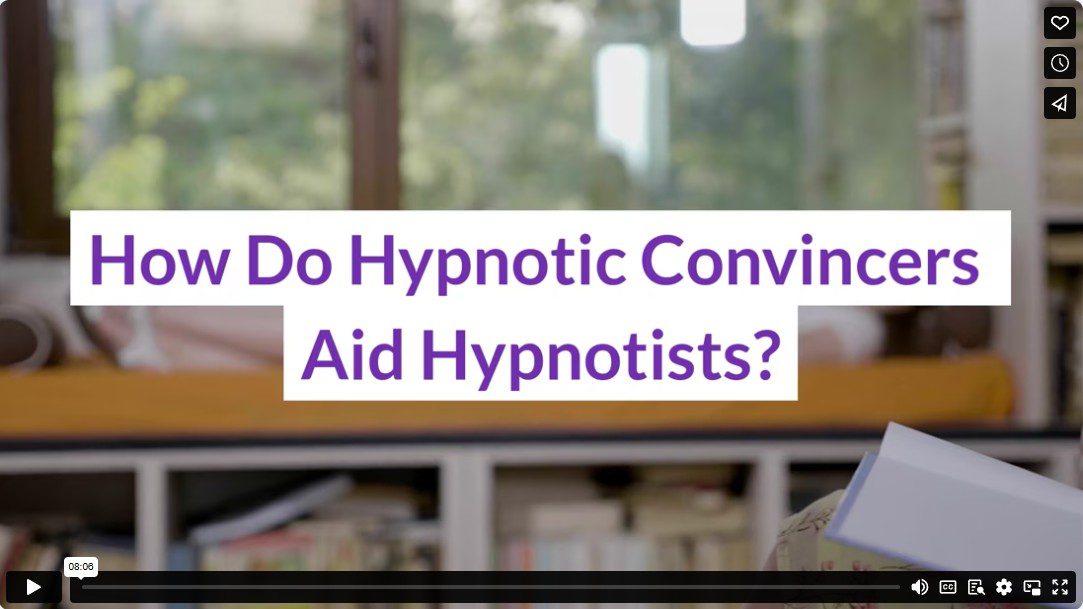As a professional hypnotist, you know how important it is for both you and your client to feel secure and confident during the hypnosis process. And yet, even the most seasoned practitioners sometimes wonder: Is my client truly in trance? If you’ve ever felt that question tugging at the edges of your awareness, you’re not alone. This is precisely where hypnotic convincers can become some of your most valuable tools.
These simple, yet profoundly effective techniques help reassure both you and your client that hypnosis is unfolding beautifully. They are not gimmicks—they are vital bridges that connect intellectual curiosity with deep experiential trust, opening the way for lasting change.
Examples of convincers include:
- Hand Lock: You tell your client that their hand is locked to the table, and they are unable to move it—no matter how hard they try.
- Heavy Book: You give your client a book and tell them that it is becoming heavier. They can feel the weight change.
- A Taste of Lemon: You tell your client that they are tasting a lemon. In response, they experience the sourness of it, convincing them of the power of suggestion to alter sensory experiences.
- Finger Magnet: You suggest to your client that their finger will be drawn to an object or person.
- Arm Levitation: You suggest that a client raise their arm, and they do so with minimal effort.
- Time Distortion: You can use the power of suggestion and imagery to make people feel like time is passing quickly or slowly. For example, you could tell them to picture a clock and make the hands move as quickly or slowly as they want.
Whether you learned your foundational skills through an in-person program or chose to learn hypnosis in your home, it’s likely you already use some of these methods without always thinking of them as “convincers.”
Convincers can gently shift a client’s mindset from “I wonder if this is working” to “I can feel it working.” And that shift is transformational, not just for the session at hand, but for the entire therapeutic journey ahead.
Building Client Confidence Through Experience
Many clients arrive with a quiet, hidden uncertainty, even when they genuinely want to be hypnotized. Simply telling someone they’re in trance doesn’t always bridge that gap. Hypnotic convincers offer a gentle, effective way to guide your clients beyond doubt by helping them experience phenomena they cannot easily explain with logic alone.
Take, for instance, the classic hand lock technique. When a client finds their hand feeling stuck to the armrest, it’s not about forcing belief. It’s about giving them a felt experience that says, “something real is happening here.” Moments like these cultivate trust: not just trust in you, but trust in themselves, in the hypnosis process, and in their own ability to access deeper levels of their mind.
This trust lays the groundwork for all that follows. As confidence grows, so does receptivity to suggestion. Each session becomes more fluid, more responsive, and more transformative.
Reinforcing Belief to Deepen Suggestibility
One of the subtle yet profound benefits of convincers is how they plant seeds of belief that blossom over time. When clients experience hypnotic phenomena early on, that’s more than a one-time reassurance. It’s a message to their subconscious: I can be hypnotized. I can change.
This is not about manipulating belief; it’s about nurturing it. Your clients come to you wanting change, and convincers help create the conditions where change feels natural and even inevitable.
Many experienced practitioners introduce convincers early in a series of sessions. These early successes create momentum. They turn fragile hope into genuine expectation, which is a critical foundation for deep, lasting transformation.
Enhancing Your Authority as a Hypnotist
Your presence sets the tone for your client’s journey. Hypnotic convincers offer you a way to affirm your role as a capable guide without needing to assert authority overtly.
Consider the difference between saying, “You’ll begin to feel deeply relaxed,” and gently leading a client through a finger-spreading exercise that naturally creates unexpected muscular relaxation. You’ve just shown, rather than told, how hypnosis can work. When clients feel the shift for themselves, it strengthens their trust. They are far more likely to buy into the journey you’re inviting them to take and in your ability to help them navigate it.
That’s why convincers are part of the professional toolkit—not because you doubt your abilities, but because demonstrating effectiveness builds authority.
Using convincers thoughtfully is not a sign that you doubt yourself; it’s a sign of skillful authority. It reassures uncertain clients and showcases the control you have over the process. In an increasingly crowded wellness world, this kind of experiential credibility is priceless.
Using Convincers to Evaluate Client Readiness
Convincers also serve a subtle, diagnostic role. How a client responds to a convincer can offer insight into their current openness to suggestion.
A strong reaction suggests readiness for deeper work. A more hesitant or uncertain response signals a need for a little more time building rapport, refining pre-talks, or offering gentle reassurance before progressing to more targeted interventions.
This awareness allows you to adapt with compassion. If one convincer isn’t quite resonating, you can easily pivot to another. For example, perhaps you move from a hand-lock exercise to a time-distortion suggestion. Every client is unique, and every mind responds differently. Honoring that uniqueness keeps your work deeply client-centered and effective.
When sharing observations, keeping feedback positive is critical. Saying something like, “That’s a wonderful sign of how naturally responsive you are,” helps your client connect their experience with a feeling of success, further reinforcing their commitment to change.
Avoiding Overuse and Misinterpretation
As with all tools in hypnosis, how and when you use convincers matters. Overusing them, or presenting them without a clear purpose, can unintentionally create pressure or self-consciousness for your client.
To avoid this, frame convincers as opportunities for exploration, not tests. Explain that these experiences help demonstrate how their mind and body already know how to respond to suggestion. Emphasize that there’s no “right” or “wrong” way for their mind to react—only opportunities to learn and deepen the process together. Keep your tone curious, not clinical. Otherwise, clients might begin to feel like they’re being tested rather than supported.
It’s also wise to use convincers to support your work, not overshadow it. Let them be a bridge into meaningful therapeutic goals, not the main attraction of your sessions. Use them early in the relationship, or when you sense your client needs reassurance, but always return to the larger goal. That way, your sessions maintain a clear therapeutic direction. This approach ensures your sessions always remain centered around your client’s true desires for change.
Integrating Convincers into Your Hypnosis Practice
Whether you’re just starting out or are refining your approach, take time to practice your convincers until they feel second nature. Over time, you’ll find that your favorite techniques become an easy, natural part of your session flow.
Experiment with different types of convincers to discover what best suits both your personal style and your clients’ needs. Some hypnotists love the elegant simplicity of magnetic fingers; others enjoy the profound responses that time distortion exercises create. Better still, have several options available so you can choose the one that best fits a specific client’s personality and mindset.
And remember: sometimes the real impact of a convincer reveals itself not during the exercise itself, but later, when the client reflects on what they experienced. These quiet “aha” moments often carry the deepest, most lasting shifts.
Final Thoughts
Hypnotic convincers are not party tricks or tests. They are invitations. Invitations for your clients to believe in their own capacity for change. Invitations for you to step more fully into your role as a confident, compassionate guide. They help you build rapport, reinforce belief, and evaluate a client’s receptivity to change.
By integrating convincers thoughtfully into your work, you help clients experience tangible proof that change is possible and already beginning. You build the trust that allows deeper healing to unfold, session after session.
When used thoughtfully, they enhance every part of your hypnosis process from the first session to long-term results. Hypnotic convincers give you a powerful edge in creating change that sticks.
Video
Infographic
As a professional hypnotist, it is essential to ensure that both you and your client feel secure and confident during a session. Hypnotic convincers can be powerful tools in achieving this. Discover ways in which hypnotic convincers aid hypnotists in this infographic.





